Abstract
Objective
To evaluate the relationship between the completeness of revascularisation by percutaneous coronary intervention and the one-year occurrence of adverse cardiac events in patients with multivessel disease.
Patients
Patients with stable or unstable angina pectoris, or with exercise-induced ischaemia, were enrolled in the Coronary Angioplasty versus Bypass Revascularisation Investigation (CABRI).
Methods
In CABRI, patients were randomised to coronary bypass grafting (CABG; n=513) or angioplasty (PTCA; n=541). Revascularisation in patients randomised to PTCA was defined as complete if no lesions with a diameter stenosis <50% remained post-procedure. Patients with complete revascularisation were distinguished from those with one, two, and three or more remaining lesions, respectively. Differences in baseline characteristics and in the one-year occurrence of death, myocardial infarction, (re)CABG, and (re)PTCA between these subgroups were evaluated. Comparisons were made with patients randomised to CABG.
Results
Complete revascularisation was obtained in 148 patients randomised to PTCA (27%). In 147 (27%) cases one lesion remained, while there were 122 (23%) and 119 (22%) patients with two and three or more remaining lesions, respectively. Five (1%) patients could not be classified. The one-year rates of either death or MI were 9.5%, 5.4%, 8.2%, and 12.6% in the respective PTCA subgroups (p=0.225), and 6.2% in patients randomised to CABG (comparison with three or more remaining lesions after PTCA: p=0.017). The percentages of repeat interventions during one-year follow-up were 29.7%, 29.3%, 39.3%, and 51.3% (p<0.001), much higher than after CABG (3.5%; p<0.001).
Conclusion
Complete revascularisation by PTCA in multivessel coronary disease did not result in a lower death or MI rate compared with incomplete revascularisation. Overall the patient's prognosis after PTCA is similar to CABG, but patients with three or more remaining lesions after PTCA had a worse prognosis than CABG patients.
Keywords: stable angina pectoris, unstable angina pectoris, multivessel coronary disease, revascularisation, follow-up
Full text
PDF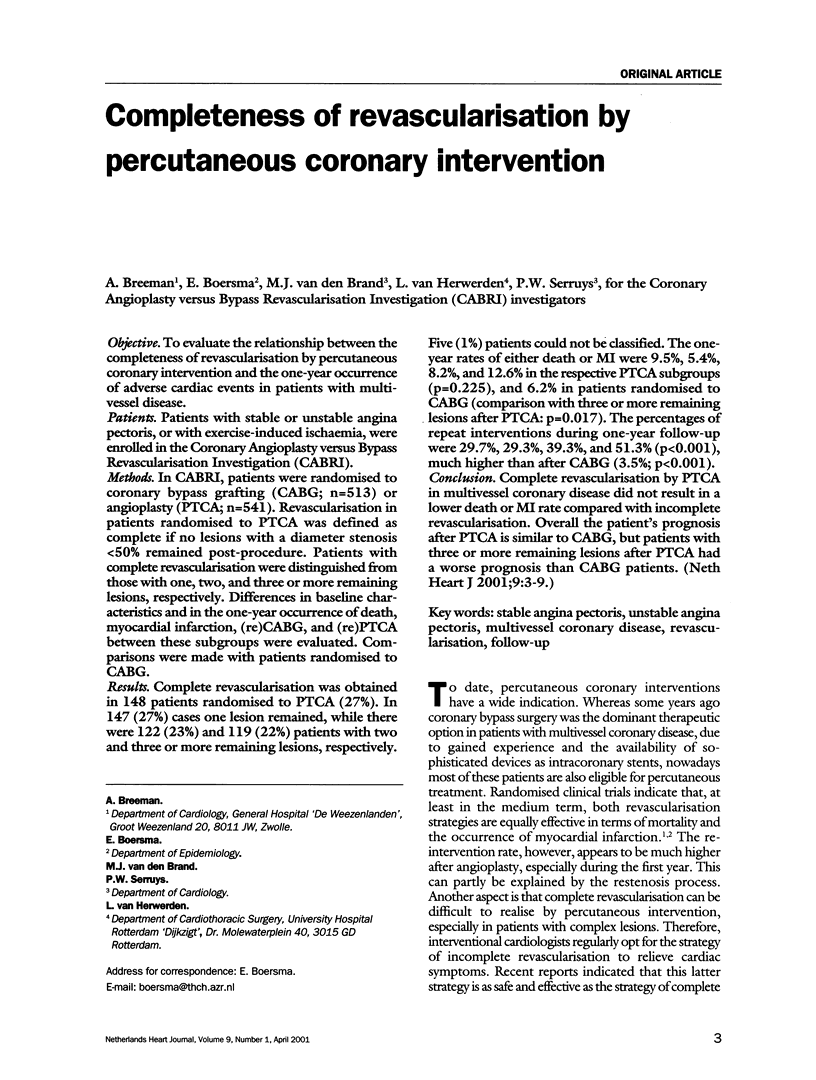
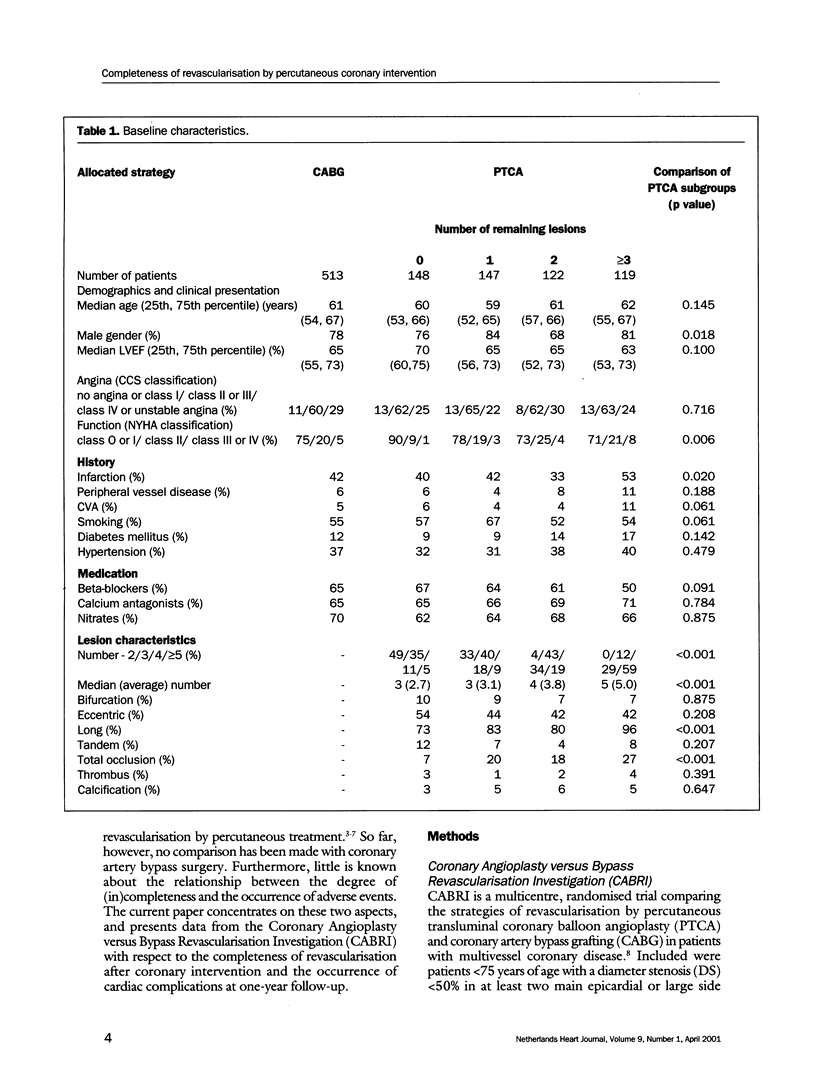
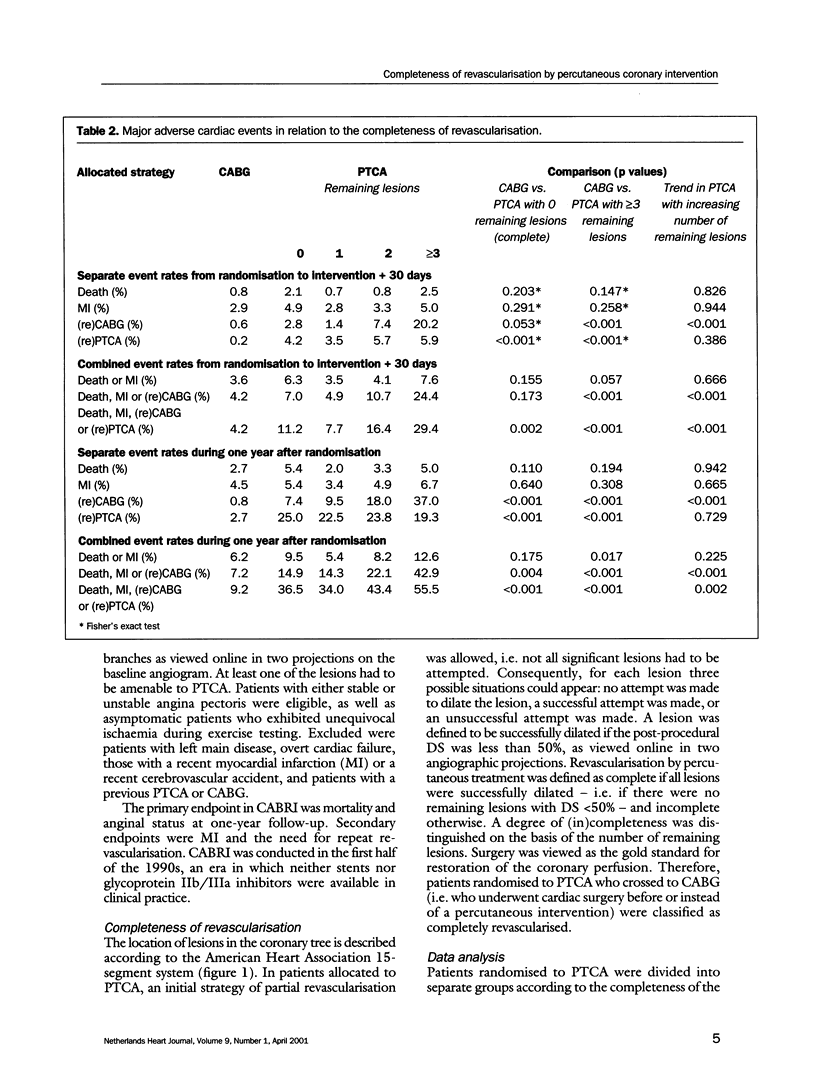
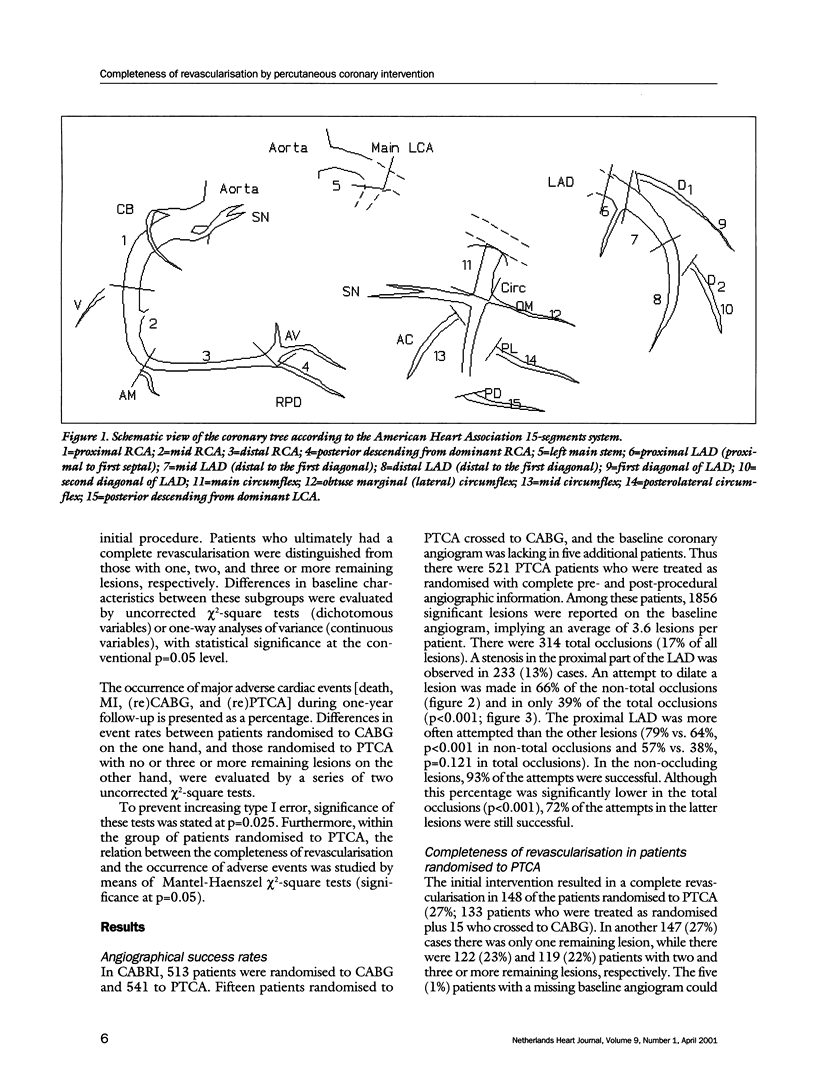
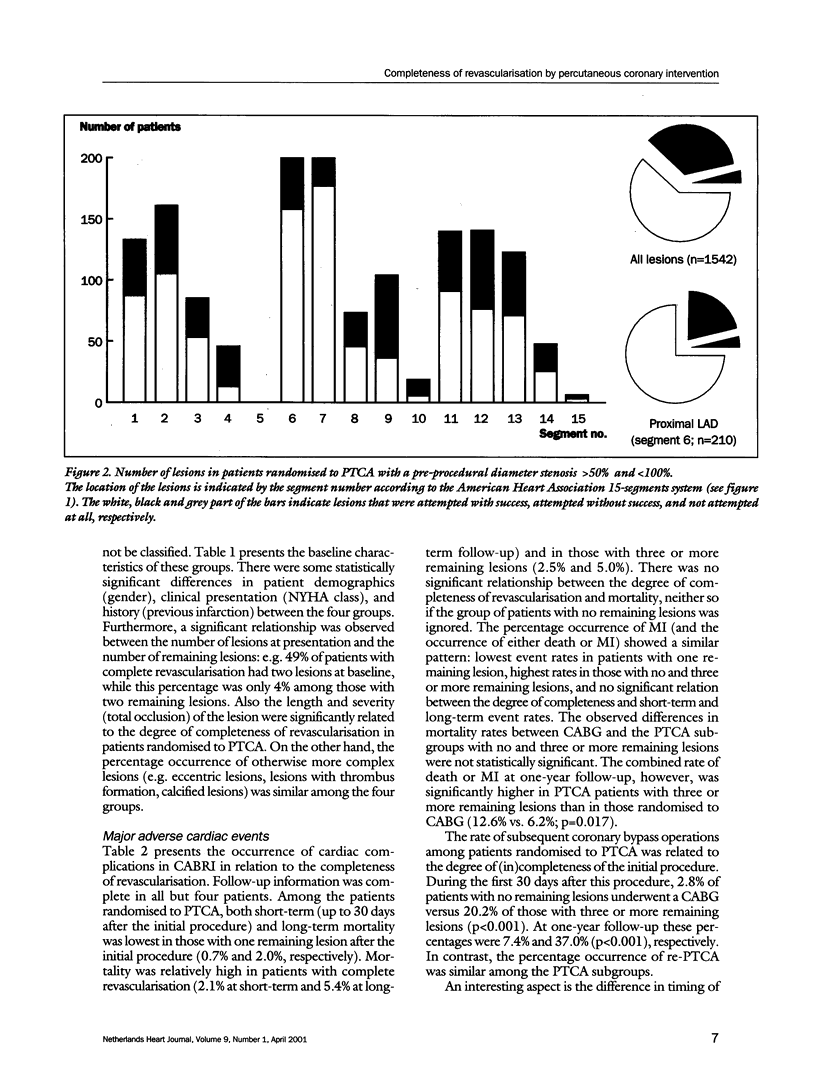

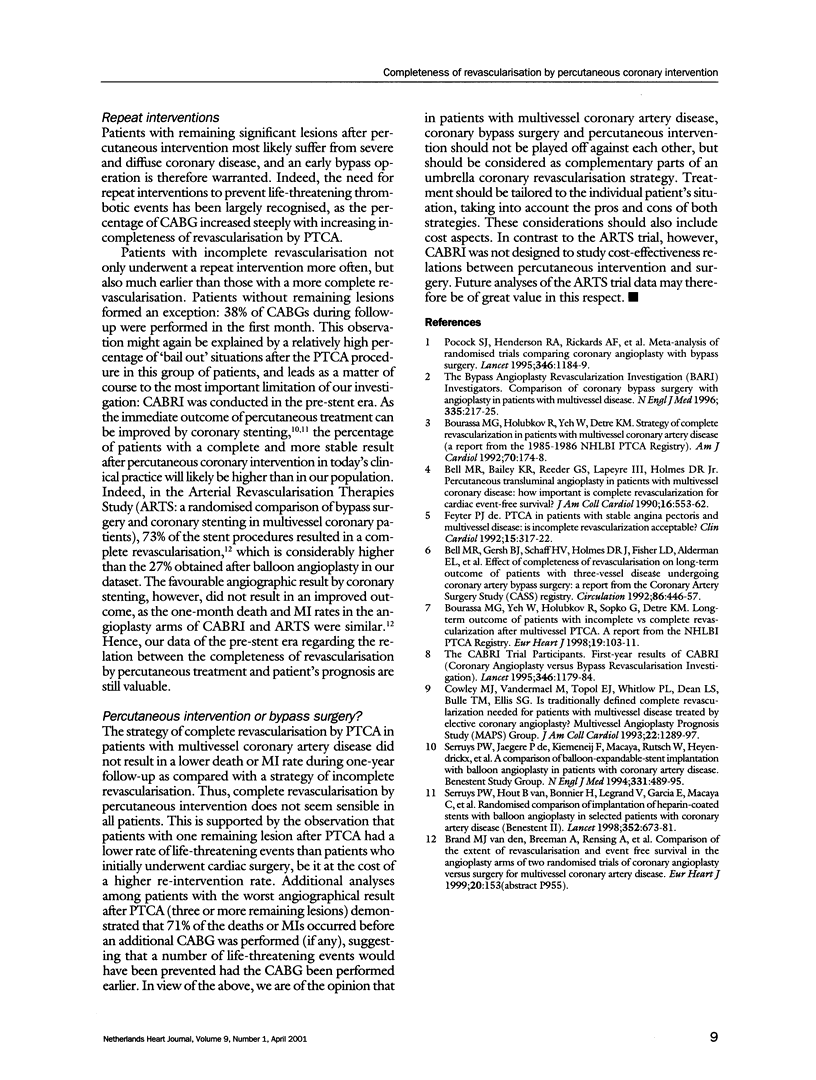
Images in this article
Selected References
These references are in PubMed. This may not be the complete list of references from this article.
- Bell M. R., Bailey K. R., Reeder G. S., Lapeyre A. C., 3rd, Holmes D. R., Jr Percutaneous transluminal angioplasty in patients with multivessel coronary disease: how important is complete revascularization for cardiac event-free survival? J Am Coll Cardiol. 1990 Sep;16(3):553–562. doi: 10.1016/0735-1097(90)90342-m. [DOI] [PubMed] [Google Scholar]
- Bell M. R., Gersh B. J., Schaff H. V., Holmes D. R., Jr, Fisher L. D., Alderman E. L., Myers W. O., Parsons L. S., Reeder G. S. Effect of completeness of revascularization on long-term outcome of patients with three-vessel disease undergoing coronary artery bypass surgery. A report from the Coronary Artery Surgery Study (CASS) Registry. Circulation. 1992 Aug;86(2):446–457. doi: 10.1161/01.cir.86.2.446. [DOI] [PubMed] [Google Scholar]
- Bourassa M. G., Holubkov R., Yeh W., Detre K. M. Strategy of complete revascularization in patients with multivessel coronary artery disease (a report from the 1985-1986 NHLBI PTCA Registry). Am J Cardiol. 1992 Jul 15;70(2):174–178. doi: 10.1016/0002-9149(92)91271-5. [DOI] [PubMed] [Google Scholar]
- Cowley M. J., Vandermael M., Topol E. J., Whitlow P. L., Dean L. S., Bulle T. M., Ellis S. G. Is traditionally defined complete revascularization needed for patients with multivessel disease treated by elective coronary angioplasty? Multivessel Angioplasty Prognosis Study (MAPS) Group. J Am Coll Cardiol. 1993 Nov 1;22(5):1289–1297. doi: 10.1016/0735-1097(93)90532-6. [DOI] [PubMed] [Google Scholar]
- First-year results of CABRI (Coronary Angioplasty versus Bypass Revascularisation Investigation). CABRI Trial Participants. Lancet. 1995 Nov 4;346(8984):1179–1184. [PubMed] [Google Scholar]
- Pocock S. J., Henderson R. A., Rickards A. F., Hampton J. R., King S. B., 3rd, Hamm C. W., Puel J., Hueb W., Goy J. J., Rodriguez A. Meta-analysis of randomised trials comparing coronary angioplasty with bypass surgery. Lancet. 1995 Nov 4;346(8984):1184–1189. doi: 10.1016/s0140-6736(95)92897-9. [DOI] [PubMed] [Google Scholar]
- Serruys P. W., de Jaegere P., Kiemeneij F., Macaya C., Rutsch W., Heyndrickx G., Emanuelsson H., Marco J., Legrand V., Materne P. A comparison of balloon-expandable-stent implantation with balloon angioplasty in patients with coronary artery disease. Benestent Study Group. N Engl J Med. 1994 Aug 25;331(8):489–495. doi: 10.1056/NEJM199408253310801. [DOI] [PubMed] [Google Scholar]
- Serruys P. W., van Hout B., Bonnier H., Legrand V., Garcia E., Macaya C., Sousa E., van der Giessen W., Colombo A., Seabra-Gomes R. Randomised comparison of implantation of heparin-coated stents with balloon angioplasty in selected patients with coronary artery disease (Benestent II) Lancet. 1998 Aug 29;352(9129):673–681. doi: 10.1016/s0140-6736(97)11128-x. [DOI] [PubMed] [Google Scholar]
- de Feyter P. J. PTCA in patients with stable angina pectoris and multivessel disease: is incomplete revascularization acceptable? Clin Cardiol. 1992 May;15(5):317–322. doi: 10.1002/clc.4960150503. [DOI] [PubMed] [Google Scholar]




